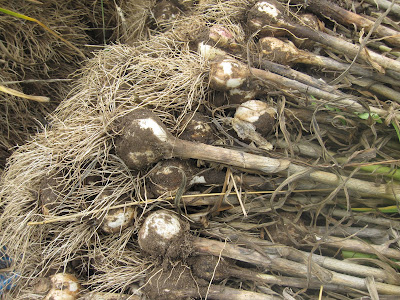
Sunday, October 2, 2011
Friday, June 3, 2011
The Natural Princess visits Wild Carrot Farm
http://thenaturalprincess.com/episodes.html
Tuesday, April 5, 2011
Wild Onions


Wednesday, January 19, 2011
Community Supported Agriculture "What You Want, When You Want It!"

Wednesday, September 15, 2010
Food Focus: a variety of Winter Squash
 Our winter squash laying out in the greenhouse, curing.
Our winter squash laying out in the greenhouse, curing.
To bake simply cut acorn squash in half, remove any seeds, add butter and bake at 350 degrees 45 to 60 minutes until squash is tender. Store in a cool dry place such as a cellar.
KABOCHA is a Japanese variety, that refers most commonly to a squash of the buttercup type. It is like a buttercup without the "button" on the blossom end.
Usually a tear-drop shape, HUBBARD SQUASH are often used as a replacement for pumpkin. Hubbard squash are good for pies and purees.
Hubbard squash can be cooked whole, but are generally peeled and boiled, cut up and roasted, or cut small and steamed or sauteed. The yellow flesh of these tend to be very moist and longer cooking times in the oven are needed.
Hubbard squash, if in good condition initially, can be successfully stored six (6) months at 50 to 55 degrees F. with 70% relative humidity. Less rot will develop in the Hubbard Squash if stems are completely removed before storage.
 BUTTERNUT SQUASH usually have a tan skin. The "oranger" the color, the riper, drier, and sweeter the squash. The bright orange, moist flesh tastes best after a few weeks storage.
BUTTERNUT SQUASH usually have a tan skin. The "oranger" the color, the riper, drier, and sweeter the squash. The bright orange, moist flesh tastes best after a few weeks storage.
 SPAGHETTI SQUASH is a small, watermelon shaped variety ranging size from 2 to 5 pounds or more. It has a golden-yellow, oval rind and a mild, nut-like flavor. When cooked, the flesh separates in strands that resemble spaghetti pasta.
SPAGHETTI SQUASH is a small, watermelon shaped variety ranging size from 2 to 5 pounds or more. It has a golden-yellow, oval rind and a mild, nut-like flavor. When cooked, the flesh separates in strands that resemble spaghetti pasta. BUTTERCUP SQUASH is one of the most common varieties of winter squash with a turban-shape (a flattish top and dark green skin), and normally heavy (weighing 3-5 pounds), with dense yellow-orange skin.
BUTTERCUP SQUASH is one of the most common varieties of winter squash with a turban-shape (a flattish top and dark green skin), and normally heavy (weighing 3-5 pounds), with dense yellow-orange skin. SWEET DUMPLING is a small, mildly sweet-tasting squash resembling a miniature pumpkin with its top pushed in. It has a cream-colored skin with green specks or can be multi-colored like the Carnival (pictured left).
SWEET DUMPLING is a small, mildly sweet-tasting squash resembling a miniature pumpkin with its top pushed in. It has a cream-colored skin with green specks or can be multi-colored like the Carnival (pictured left).Monday, August 2, 2010
USDA Certified Organic Flower Bouquets
- 1 tbsp. sugar (food source)
- 1 tsp. bleach (anti-bacterial)
- 1 tsp. lemon juice or vinegar (lowers pH & aids in water uptake)
Thoroughly mix above ingredients in vase of water. Re-cut stems using a knife to avoid smashing stem. Change water and re-cut stems every few days.
Tuesday, July 20, 2010
The Great Garlic Harvest!
 The happy harvesters from left to right - Ben, Farmer Mark, Selah, Ally, Farmer Joanie, Mary, Katy, Molly; and down in front - Caleb a/k/a "Big Tuna"
The happy harvesters from left to right - Ben, Farmer Mark, Selah, Ally, Farmer Joanie, Mary, Katy, Molly; and down in front - Caleb a/k/a "Big Tuna" Everyone is lined up on either side of the garlic bed. The soil has been loosened; they are pulling up the bulbs, shaking off some of the dirt and stacking the garlic on pallets.
Everyone is lined up on either side of the garlic bed. The soil has been loosened; they are pulling up the bulbs, shaking off some of the dirt and stacking the garlic on pallets. Next, the garlic will be bunched and hung to cure for two to three weeks.
Next, the garlic will be bunched and hung to cure for two to three weeks.- The first known labor strike was over garlic. Slaves forced to build the great Egyptian pyramids refused to work without a daily garlic ration.
- At ancient Greek and Roman weddings, the brides carried bouquets of garlic and other herbs instead of flowers.
- Garlic is a member of the onion family which also includes leeks and shallots.
- Garlic is considered both a vegetable and an herb.
- The first recorded writings of garlic were in Sanskrit in 5000 B.C.
- On-going medical research is confirming all the old wives tales about the benefits of eating garlic. Regular consumption of garlic reduces bad cholesterol and increases good cholesterol, helps fight respiratory infections, improves circulation and so much more.
- To remedy "garlic breath" try chewing a little raw parsley, a lemon wedge or drink green or mint tea.





.jpg)
 Fun Facts about Garlic:
Fun Facts about Garlic: 

